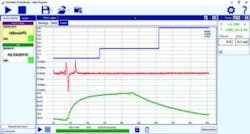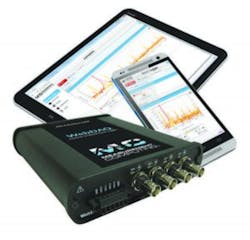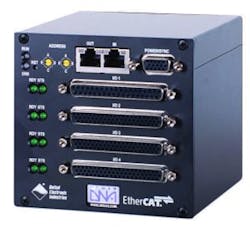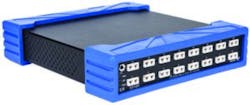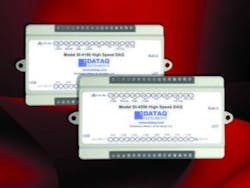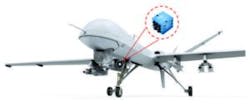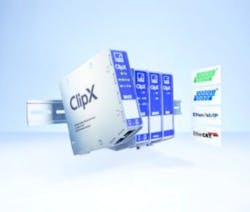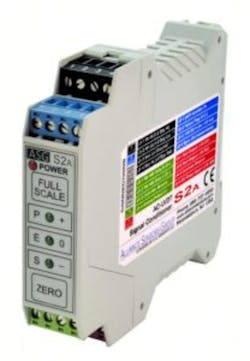Data-acquisition systems are coming to market to help capture real-world analog signals for computer analysis, control, and management. Expanding on our last coverage of the topic in our October 2017 print issue,1 several companies including AMETEK VTI Instruments, DATAQ Instruments, Diversified Technical Systems (DTS), HBM, H.G. Schaevitz LLC, Measurement Computing Corp. (MCC), Tektronix, and United Electronic Industries (UEI) have reported news on some aspect of data-acquisition technology in a variety of markets.
Bob Judd, director of marketing at UEI, cited the breadth of applications his company’s products serve. “We work with customers in virtually every industry,” he said. “I suspect we’ve sold to every company in the S&P 500 that is not a bank or insurance company. (And we have sold to labs at some insurance companies!)” He said that military/aerospace is certainly a major target, but the company also serves automotive, oil and gas, nuclear energy, white goods testing, HVAC, and more applications.
Menna Siddiqui, product marketing engineer at Measurement Computing Corp. (MCC), described data acquisition as “…the process of digitizing data from the world around us so it can be displayed, analyzed, and stored in a computer.” She added in a recent blog post, “All data-acquisition systems consist of three essential elements—sensor, signal conditioning, and analog-to-digital converter (ADC).”2 The article on p. 36 describes some recently introduced sensors, and many more will be on hand at Sensors Expo June 26-28 in San Jose. This article focuses on the other two elements.
DAQ and multimeter logging system
One of the newest DAQ products to hit the market is the Keithley DAQ6510 data-acquisition and logging-multimeter system plus KickStart 2.0 instrument-control software from Tektronix, introduced in April. (See page 30 for more on the simultaneously introduced DMM6500 6½-digit bench/system digital multimeter.) Bob Green, senior market-development manager, said the new DAQ6510 addresses the needs of environmental test, failure analysis, and quality-control engineers who need to quickly set up tests on a statistically significant sample of products.
With its 5-in. (12.7-cm) touchscreen display, the DAQ6510 simplifies setup, execution, monitoring, and analysis of multichannel-measurement systems. With previous data- logging instruments, engineers running long-term tests have been unable to assess how well a test is proceeding, Smith said, adding that the DAQ6510 solves that problem with a status display that, at a glance, will tell the engineer whether any channel measurements are outside of limits or if measurements have over-ranged. Built-in plotting functions allow users to display up to 20 different plots from 20 channels in one graph and easily drill down using pinch and zoom controls and then conduct further analysis using cursors and statistical functions. The setup, execution, monitoring, and analysis can be done on the instrument without the need for a PC.
To test a statistically significant number of devices, the DAQ6510 can be combined with 7700 Series plug-in switch modules to test as many as 80 devices in one test system. With 12 plug-in switch modules including multiplexers, multiplexers with cold-junction compensation for thermocouple temperature measurements, a matrix switch module, a control module, digital I/O module, and gigahertz switch modules, the DAQ6510 delivers the flexibility to build nearly any type of multichannel test system. The DAQ6510 offers test-script processing capability to give engineers the ability to select the optimum interface and to customize instrument measurements and displays.
In addition, new KickStart 2.0 coding-free instrument-control software supports engineers who prefer using a PC to set up automated data-acquisition and test applications (Figure 1). Jennifer Cheney, product marketing engineer, said KickStart 2.0 removes the complexity from multi-instrument setups, enabling control from a single software package with quick instrument discovery supporting GPIB, LAN, and USB interfaces. She added that the software supports fast data visualization—enabling users to get real data just minutes after taking an instrument out of the box. Users can see results from multiple instruments in a single dashboard format, she said. In data-logging applications, the software supports the collection of millions of readings from each instrument, providing safe archival of raw test data for compliance with regulator standards. The software also streamlines the configuration of multichannel DAQ instruments, she added.
Mobile computing
Siddiqui at MCC said in an email message that over the past few years, the company has seen a tremendous growth in demand for mobile computing devices. “As tablets replace PCs in the workplace, the ability to capture and analyze data while disconnected from your test fixture is a need that has become increasingly apparent,” she said.
To that end, the company offers its MCC WebDAQ Series, which Siddiqui described as offering a complete and easy-to-use remote data-logging solution (Figure 2). “An embedded web server allows you to configure simple to complex data-logging applications, set alarm conditions, record the data locally or download it remotely, and view your data in real-time from anywhere on an Internet-enabled device,” she said. “With devices serving data through the web, as opposed to a Bluetooth connection, for example, you can monitor your measurements from any device connected to the network. You can even VPN into the network remotely and control your acquisition.”
The first two devices in this series are the WebDAQ 316, a high-resolution temperature data logger, and the WebDAQ 504, a vibration and acoustic data logger for direct measurement of IEPE sensors.
“More companies are moving towards remote monitoring of their test systems, especially in plant maintenance and equipment monitoring,” Siddiqui said. “These industries need a predictive-maintenance solution that automates the data logging and continuously compares key measurements, such as vibration and temperature, to baseline values in order to predict any equipment malfunctions and examine issues before they become costly failures. With online data logging using the WebDAQ Series, organizations can gain better insight into the health of their equipment and use this data to schedule and plan maintenance only when necessary. This leads to more revenue, reduced cost, and the ability to predict potential failures while increasing safety.”
EtherCAT in the United States
Judd at United Electronic Industries commented on his company’s product lineup. “Perhaps the largest new addition to our family is our EtherCAT-based Cubes” (Figure 3), he said. “EtherCAT is an extremely popular DAQ platform in Europe, but we’re seeing more and more adoption here in the states, especially in the automotive industry. Though we have products that provide roughly equivalent (and often superior) performance, many of the large automotive firms are excited about the prospect of using a standard that
allows their software to easily work with hardware from multiple vendors.”
He also commented on new capability for the company’s UEIPAC embedded-control system. “Included in the new systems are IEEE-1588 support, allowing us to easily synchronize systems worldwide,” he said. “The new system also allows the installation of solid-state hard drives. Finally, we are seeing more and more requests from customers that we run over encrypted Ethernet. Our new revision CPU uses a processor that has built-in IpSec encryption.”
He also noted that UEI has been building systems that allow data to be stored on a remote server for many years. “However, as I’m sure you’re aware, the industry has now adopted the name IoT (or IIoT) for this type of application,” he said. “There are two big differences between our legacy systems and the IoT deployments: First, the IoT deployments are almost universally sending data to the cloud rather than a private server. Second, there are standard software connections, and in particular, our embedded controllers are all set up to work seamlessly with MQTT”—the lightweight machine-to-machine (M2M) and IoT connectivity protocol.
Judd cited several unique features of his company’s products, the first being extremely high density. “Our Cubes and RACKs simply provide more I/O channels per cubic inch (or square inch in a 19-in. rack) than other vendors,” he said. He also cited ruggedness. “Most DAQ vendors target laboratory applications and even use plastic enclosures,” he said. “UEI chassis are rated for use from -40°C to 85°C; they will operate while subject to 5g vibration or 100g shock.”
He also mentioned an extremely wide I/O selection. “Everybody measures voltage, can read a thermocouple, and can handle DIO,” he said. “This is all many applications need. However, if you need to monitor RVDT/LVDT, synchro/resolvers, input from avionics devices, odd-ball serial protocols like HDLC/SDLS or SSI, IRIG-B timing, and many more, there are COTS boards from UEI” that can handle the task. In addition, the company’s products can run as standalone embedded devices or tethered to a host computer, he said. Finally, he added, UEI’s software makes it easy to import/export from/to the many data-reduction, analysis, and management tools on the market.
Plug-and-play software
AMETEK VTI Instruments in February introduced its EXLab Express, a plug-and-play data-acquisition software package. A version of VTI’s EXLab data-acquisition software, EXLab Express allows users of the EX1401 thermocouple/voltage-measurement instrument to acquire data without programming. It simplifies instrument configuration, acquisition, and data display without sacrificing functionality or performance. EXLab Express features include intuitive, icon-based setup and control; spreadsheet-style channel configuration; snapshot display with data export; support for independent sampling rates for each instrument; and real-time online graphical data analysis.
measurement Instrument
The EX1401 (Figure 4) was designed to be used in any test environment
that requires accurate temperature
measurement and repeatability. The EX1401 features a 24-bit ADC on each channel and 1,000-V channel-to-channel isolation. These features yield a temperature accuracy of ±0.20°C at sample rates up to 20k samples per second on each channel. Other features include an LXI Ethernet interface, built-in self-test capabilities, parallel data storage, and standalone
autonomous operation. Applications include automotive and battery testing, jet-engine testing, highly accelerated life test/highly accelerated stress screening (HALT/HASS), and health monitoring.
USB DAQ systems
DATAQ Instruments’ recent product offerings include the complementary models DI-4108 and DI-4208 USB data-acquisition systems (Figure 5). Both instruments are identical except for measurement range, and they can be connected for higher channel counts and mixed measurement ranges using DATAQ Instruments’ ChannelStretch technology.
data-acquisition systems
Common features are eight differential analog inputs (armored to withstand up to 120 VRMS) and seven bidirectional discrete ports. Two ports can be programmable as a counter or frequency input. The analog inputs are multiplexed to an ADC that provides 12- to 16-bit resolution as a function of sample rate. Sample rate ranges from 2.2 samples per hour to 160,000 samples per second. Model DI-4108 provides six measurement ranges from ±200 mV to ±10 V. Model DI-4208 supports ±2 to ±100 V. All ranges are programmable per channel, and instruments may be combined with ChannelStretch in any combination up to 128 analog channels and 112 digital ports.
Included is DATAQ’s WinDaq software to allow ready-to-run data acquisition, display, playback, and analysis, as well as .Net classes, and ActiveX controls for programming the DI-4108 or DI-4208 under Windows. A documented instrument protocol is also provided for other operating systems.
Air, land, and sea
Diversified Technical Systems (DTS) touted its SLICE IP68 data-acquisition system for air, land, and sea applications, saying the system is designed to measure physical signals in extreme test environments (Figure 6). With a footprint of 60 x 60 mm, SLICE IP68 can be embedded in most test articles, even in applications with size and mass constraints. The rugged enclosure features sealed layers and IP68-rated connectors and meets
MIL-STD-810G for temperature, altitude, shock, and vibration. SLICE is suitable for testing in inclement weather or in non-pressurized environments where quick altitude changes may result in condensation on the instrumentation.
SLICE features onboard signal conditioning and supports a variety of external sensors including bridge and IEPE transducers for gathering measurements like acceleration, displacement, strain, pressure, temperature, and voltage. Data writes directly to 16 GB of internal flash memory. The unit is self-contained with the microprocessor, control circuits, and a sensor interface complete with excitation and variable-gain circuitry plus a 16-bit ADC. The modular system is configurable based on required features and channel count, including variable sampling rates up to 500k samples per second per channel. The 3-channel sensor input layers stack up to 24 channels, which can be daisy-chained for higher channel counts.
Signal conditioners
For its part, HBM has announced a new industrial signal conditioner called ClipX. The module adapts to any measurement task, regardless of whether it is used with single- or multiple-channel applications, manufacturing machines, or production monitoring.
ClipX (Figure 7) allows for easy implementation of any number of individual, standalone measurement chains or measurement systems, with up to six devices that can communicate with each other. The signal conditioner provides all the latest automation interfaces to integrate the device into comprehensive, digital-control concepts incorporating PROFINET, PROFIBUS, Ethernet/IP, and EtherCAT technologies.
Both analog and digital measurement chains can be built up with ClipX, the company said, adding that HBM’s sensors are optimally matched to the ClipX signal conditioner and provide interference-proof measurement results. An intuitive web interface also allows remote operation, parameterization, and diagnosis. ClipX is self-monitoring and helps prevent machine downtime due to the early detection of faults (predictive maintenance).
And finally, H.G. Schaevitz LLC in April introduced its latest LVDT signal conditioner, the S2A (Figure 8). This LVDT signal conditioner offers smart and fast LVDT/RVDT setup and has been engineered to work with the widest range of LVDTs, RVDTs, and inductive half-bridge sensors, including 3-wire GE LVRTs and GE gas turbine buck-boost-style LVDTs. The signal-conditioning module has cybersecurity, tamper prevention, and notification features.
The S2A offers push-button calibration, built-in null indication, four excitation frequencies, eight analog DC outputs (six DC voltage and two current-loop outputs), 16 addresses for RS-485 digital communications, hot-swap capability, and advanced master/slave capability to reduce cross talk. EE
References
1. Nelson, Rick, “Keep cool, calm when making temperature, vibration measurements,” EE-Evaluation Engineering, October 2017, p. 18.
2. Siddiqui, Menna, “What is Data Acquisition?” MCC Data Acquisition News and Resources Blog, Feb. 1, 2018.
For more information:
AMETEK VTI Instruments
DATAQ
DTS
H.G. Schaevitz LLC
HBM
Measurement Computing Corp.
Tektronix
United Electronic Industries

